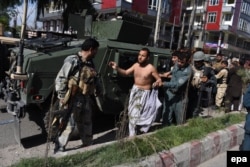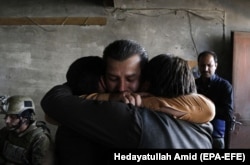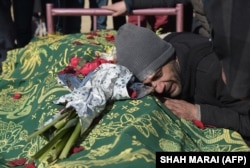The Taliban and the Islamic State (IS) militant group might be foes on the battlefield in Afghanistan, but off it they are united against a common enemy: the Afghan media.
Both extremist groups have threatened and deliberately targeted major TV and radio stations and their staff members recently across Afghanistan, carrying out deadly attacks that have killed dozens of journalists and media employees.
The attacks have made Afghanistan one of the deadliest countries in the world for journalists and forced media companies to adopt new security measures, although it is unclear if the violence has had a chilling effect on news coverage.
“They want to create fear among journalists so the media does not report their atrocities,” says Najib Sharifi, head of the Afghan Journalists Safety Committee (AJSC), a local media watchdog. “They also want to capture headlines and assert their power and visibility. They want to silence the media because they see the media as a threat to their propaganda strategies.”
'Serving Infidels'
In what was arguably the most high-profile attack of its kind on a media organization in Afghanistan, a suicide bomber in January 2016 attacked a minibus and killed seven employees of Tolo TV, the country’s largest private television network.
Those killings came months after the Taliban said it no longer recognized Tolo TV and another major TV network, 1TV, as media outlets and considered them "military objectives.”
The fundamentalist militant group said the move was a direct response to the commercial networks' coverage of the Taliban’s brief takeover of the northern city of Kunduz in September 2015 -- specifically, their reports of Taliban fighters allegedly raping women at a female hostel there. The Taliban denied the reports, saying the coverage was an "example of propaganda by these satanic networks."
Since then, IS militants have adopted a similar strategy, and there have been several major attacks against media outlets. In May, IS militants attacked the building of state-run Radio Television Afghanistan (RTA) in the eastern city of Jalalabad. Among the six people killed were four RTA employees, including a driver, a guard, and two technical personnel, as well as two policemen.
On November 7, gunmen killed a security guard and opened fire on the staff of Shamshad TV, a private television station in Kabul, in an attack that was claimed by IS militants.
The IS-affiliated Voice of the Caliphate radio station, which broadcasts in eastern Afghanistan, warned it would continue to target media outlets and their journalists if they did not stop “serving infidels,” a reference to foreigners. The broadcast said the group was “monitoring your actions and are well aware of your evil intentions and plans.”
“Propaganda is a big pillar of the war being waged by the Taliban and IS,” says Sharifi. “They want their narratives to dominate the political and military landscape. They see the media as a big obstacle to advancing their propaganda goals, so they use coercion to silence the media and make them resort to self-censorship.”
Journalists [in Afghanistan] are conscious of the implications of critical reporting. The media is consciously and unconsciously self-censoring. Sometimes, the media may not run a story because they are afraid of the security implications.”-- Kabul-based BBC journalist
Steven Butler, Asia program coordinator at the Committee to Protect Journalists, a New York-based media watchdog, says the attacks are also designed to inspire new recruits.
“A public show of brutality both inspires and intimidates,” he says.
Since IS militants emerged in Afghanistan in 2015, they have fought deadly clashes with the Taliban in the country’s east and south, although they have also conducted joint operations against Afghan security forces. Many IS fighters in Afghanistan are former members of the Afghan Taliban, Pakistani Taliban, and the Islamic Movement of Uzbekistan (IMU).
'Self-Censoring'
Lotfullah Najafizada, the director of Tolo News, says the 2016 attack has not affected the news channel’s coverage, although it has prompted its staff to be on heightened alert.
“The attack and the threats thereafter have certainly changed the way we operate from a security perspective, but not the way we report as an independent news channel,” Najafizada said.
But a BBC journalist in Afghanistan, who spoke on condition of anonymity because of security concerns, says the attacks have taken a toll on the media.
“Journalists are conscious of the implications of critical reporting,” says the Kabul-based journalist. “The media is consciously and unconsciously self-censoring. Sometimes, the media may not run a story because they are afraid of the security implications.”
Violence Against Reporters
Afghanistan's media development is often cited as one of the biggest achievements of the past decade, following years of Taliban strictures or outright prohibitions on all forms of music and television, as well as independently reported news.
Despite the gains, independent media have come under constant attack and pressure not only from militants but also from religious leaders, ex-warlords, and sometimes even the government itself.
International media watchdogs have said militants have greatly contributed to the climate of fear by explicitly targeting journalists for reporting deemed unfavorable and have condemned the impunity enjoyed by those responsible for crimes of violence against media personnel in Afghanistan.
According to a report issued by the AJSC in July, in the first six months of 2017, 10 journalists were killed and 73 cases of violence had been reported including "killing, beating, inflicting injury and humiliation, intimidation, and detention," marking a 35 percent increase over the same period last year.
AJSC said at least 13 journalists and media personnel were killed in 2016. In 2015, the figure was four, said the watchdog.










